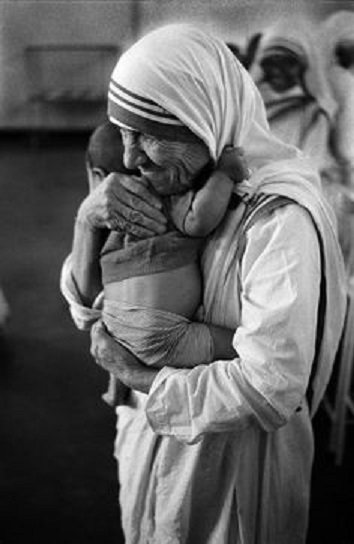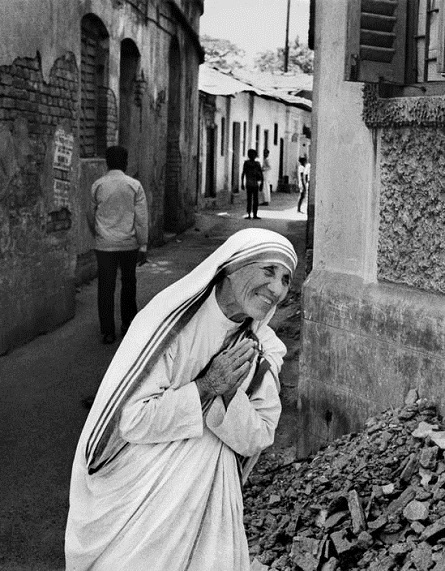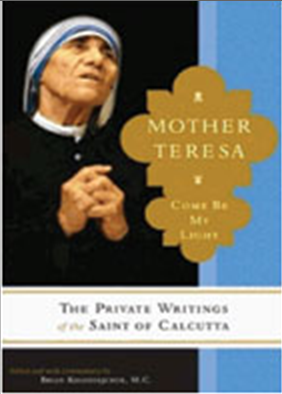St. Teresa of Calcutta
This is a collection of articles archived for the excellence of their
content. You can update or correct this page, and/ or send photographs to the Facebook page, Indpaedia.com. All information used will be duly acknowledged. |
Contents |
Biographical highlights
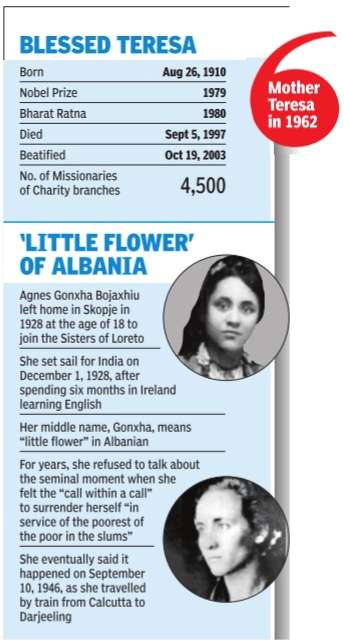
The Times of India


Born Agnes Gonxhe Bojaxhiu on August 26, 1910, Mother Teresa came to India in 1929 as a sister of the Loreto order. In 1946, she received what she described as a "call within a call" to found a new order dedicated to caring for the most unloved and unwanted, the "poorest of the poor."
In 1950 she founded the Missionaries of Charity, which went onto become a global order of nuns — identified by their trademark blue-trimmed saris — as well as priests, brothers and lay co-workers.
She was awarded the Nobel Peace Prize in 1979.
She died in 1997 after a lifetime spent caring for hundreds of thousands of destitute and homeless poor in Kolkata, for which she came to be called the "saint of the gutters."
St. John Paul II, her most ardent supporter, fast-tracked her for sainthood and beatified her before a crowd of 300,000 in 2003.
According to correspondence that came to light after she died in 1997, Mother Teresa experienced what the church calls a "dark night of the soul" — a period of spiritual doubt, despair and loneliness that many of the great mystics experienced. In Mother Teresa's case, it lasted for nearly 50 years — an almost unheard of trial.
For the Rev. Brian Kolodiejchuk, the Canadian priest who spearheaded Mother Teresa's saint-making campaign, the revelations were further confirmation of Mother Teresa's heroic saintliness. He said that by canonizing her, Francis is recognizing that Mother Teresa not only shared the material poverty of the poor but the spiritual poverty of those who feel "unloved, unwanted, uncared for."
Pope Francis on 4 Sept 2016 declared Mother Teresa a saint.
Rev. Brian Kolodiejchuk's biography
Rev. Brian Kolodiejchuk is the Canadian priest who spearheaded Mother Teresa's saint-making campaign.'
Helping Hands
Reviewed By Nilofer Sultana
It can be said without any exaggeration that even volumes cannot adequately encompass the multi-dimensional and towering personality of Mother Teresa. The book, a posthumous autobiography, was referred to as being full of ‘stunning revelations’ by the New York Times. It unveils interesting details about Mother Teresa’s very private life which were mainly garnered from her letters to the Archbishop, contemporary priests, her colleagues and sisters.
Tears are sure to well up in readers’ eyes as we get involved in the book and that frail but indefatigable figure clad in a simple white sari flashes before our eyes.
The pages of this edifying book reinforce belief in the fact that Mother Teresa was love personified. Above all else was her immeasurable love for God and His creatures.
Her unswerving resolve to say yes to God under all circumstances is reflected in one of her letters. She writes: ‘I made a vow to God, not to refuse Him anything. I always wanted to give Him something beautiful without reserve.’
It was for this profound love for God and Christ that she decided to be a nun at the age of 18 and left her family and friends to commence life as a missionary. This parting was not easy for her as her verses aptly convey:
I am leaving my friends Forsaking family and home, My heart drives me onward, To serve my Christ.
Her ever-growing love for God and Christ led to her intense love for the poorest people in the slums of India. She claims she felt a strange darkness within and a voice that seemed to call her incessantly, ‘Come, come carry me to the holes of the poor. Come be my light.’ She had visions of Christ summoning her to the poor, suffering the excoriations of want, misery, disease and loneliness. She sought the permission of the parish priest F. Perier to leave the convent and the Sisters of Loreto.
In her letter to him she wrote: ‘Let me offer myself and those who join me for the unwanted poor, the little street children, the sick and dying, the beggars — Let me go into their very holes and bring in their broken homes joy and peace.’
Readers will definitely be touched after reading about the difficulties Mother Teresa had to encounter for the fulfillment of her mission. With an indomitable will, she suffered hunger pangs, walked long distances and worked tirelessly for hours to be there for those who needed her. She unfailingly reached the multitudes suffering through the grave agonies of war (World War II) and also the great famine of 1942-43 in the Bengal.
Along with other members of her order — which she called the Missionaries of Charity — she carried the victims of famine, who were dying in the streets, to the Kali Temple in Kolkata to offer them accommodation, provide them food and medical care and to tend to their sores and wounds with tender concern.
Along with other members of her order — which she called the Missionaries of Charity — she carried the victims of famine, who were dying in the streets, to the Kali Temple in Kolkata to offer them accommodation, provide them food and medical care and to tend to their sores and wounds with tender concern.
The book tells us that though she was often without any money, nothing deterred her from bringing comfort and solace to those languishing in the squalour of poverty.
She won accolades from more quarters than one but one striking trait of her character was her belief in self-effacement. She wrote to the archbishop, ‘I am afraid we are getting too much publicity. Please pray for me that I be nothing for the world and the world be nothing for me.’
Her thoughts were focused on the poor and unwanted and not on her personal achievements even while accepting the Nobel Peace Prize in 1979. Addressing the audience, she begged them to look for those who lived the agonising poverty of being unwanted, unloved and uncared for by their very own.
The book is a must read in these times of selfishness, greed, rapacity and bigotry. No one can deny the truth of Mother Teresa ‘s words like, ‘Tuberculosis and cancer are not great diseases, the much greater disease is to be unwanted and unloved. This is what is happening in every home, every family.’
Her open letter to George Bush and Saddam Hussein is bound to make us tearful. ‘I plead to you for the poor and those who will become poor if war that we all dread happens. Please listen to the will of God. He has created us to be loved by His love and not destroyed. It is not for us to destroy what God has created.’
The book provides a rare opportunity to revive beautiful memories of a legendary figure like Mother Teresa through her own letters.
Mother Teresa: Come be my life
Edited By Brian Kolodiejchuk, MC
Rider Books, London
Available with Paramount Books, Karachi
ISBN 978-1-84-604130-3
404pp. Rs695
Disciple Sunita Kumar’s recollections
Sunita Kumar’s recollections, recorded by Subhro Niyogi The Times of India (Delhi) Sep 04 2016
If I ever become a saint, I'll surely be one of darkness...
...I will continually be absent from heaven -to light the light of those in darkness on earth'
Sunita Kumar was a volunteer at the Missionaries of Charity for three decades and also Mother Teresa's confidante.
She tells Subhro Niyogi about the Mother she knew
`IF YOU TAKE PICTURES OF THE DESTITUTE, ENSURE THEIR DIGNITY REMAINS INTACT...'
For the millions of poor and suffering, Mother Teresa was a living saint. For me, her life was a miracle. The canonisation at the Vatican is offi cial recognition of what Kolkatans have always known. I met Mother in 1967 at the home of an Italian, Dilda Smart, who was part of a group of well-off women volunteering for the Missionaries of Charity. I decided to join them. I was struck by Mother’s lean and short fi gure. Given the enormity of her work, I had expected someone taller. She looked into my eyes, smiled and extended her hand. Her handshake was unforgettable, fi rm and warm. That was it, I knew I’d be with Mother.
She taught us how to make packets for medicines meant for leprosy patients at Gandhi Prem Niwas, Titagarh, a north Kolkata suburb. These packets were crafted such that those who don’t have fi ngers would have no trouble opening them. We also began making bandages out of saris for the patients.
Our group had women of many religions. Bina Shrikent and I were Sikh. Amita Mitter and Priti Roy were Hindu. There was Perin Aibarn, a Parsi, and Uma Ahmed, a Muslim. We were bound by our faith in Mother. She inspired faith. Once, she celebrated the silver jubilee of the Missionaries of Charity with prayers in churches, temples, mosques and gurdwaras.
We used to collect donations, hold charity fi lm shows. These stopped after she won the Nobel Prize and funds poured in. At Mother House, I handled donations and correspondence from across the world. I don’t know how or when we became close. In spite of working in sad and depressing surroundings, she was always joyful and warm. Her cheerfulness helped co-workers. Once a visitor watching Mother clean an angry wound remarked: “I wouldn’t do that for a million dollars.”
Mother replied softly: “Neither would I. I do it for Jesus.”
Mother gave others strength. At a meeting, she asked: “During the time you devote to the poor, I’d like you to sacrifi ce food.” From then on, we only drank water if thirsty, or perhaps coffee. Fulfi lling this simple request made us stronger. She made the diffi cult look easy. A doer, she led by example. She never lost patience but wanted things done immediately.
I never heard her raise her voice. She was fi rm and that told you she meant business. I began travelling with her — fi rst within the country then outside — to London, Italy and Belgium. She once said: “I taught geography for many years, but never thought I’d visit so many places I taught about.”
Mother took the sari with the blue border to the world. All sisters wear this sari, woven at the Titagarh leprosy centre.
One day in London, Mother saw a drunk man, sad and miserable. She took his hand and asked: “How are you?”
His face lit up. He replied: “After so long, I feel the warmth of a human hand.”
In 1993, I was with her on her visit to the Vatican to meet Pope John Paul II. She carried a map of Missionaries of Charity centres across the world. Mother introduced me to the Pope as a long-time associate. “Are you Christian,” the Pope asked. I told him I was Hindu (I didn’t want to explain what a Sikh is). Delighted, he smiled: “I’m so glad Mother receives support from people of all faiths, not just Christians.”
Mother was at ease in the Pope’s company, but uncomfortable with the grandeur of St Peter’s Basilica.
“They don’t need all this,” she told me. I can understand her uneasiness. She lived simply. In Mother House, the only room with a fan is the parlour for visitors. Her room, about 12ft by 8ft, was above the kitchen, unbearably hot peak summer. She had a small table and a stool. It was at this table that she did all her work for her 595 homes.
She worked late into the night; slept fi ve-six hours and took a halfhour afternoon nap.
She insisted on keeping the telephone in her room and answered all calls herself if she was home with a characteristic: ‘Yes’.
Despite her failing health, Mother continued travelling. She had her fi rst heart attack in Rome in 1980, but refused to slow down. Before the beatifi cation, the Church committee came down to investigate her candidature with many questions about her work, temperament, possessions. Mother travelled with three saris. That was all she had. She carried her travel documents and prayer books in a jute sack with a cane handle.
She was once admitted to a nursing home with a heart problem but had to be moved to another. From the stretcher, she called out to him: “Ajoy, kemon achho? (How are you Ajoy)” He was a municipal driver whom she called at odd hours to pick up the sick from the streets, transport them to her homes.
She died in her Mother House room at 9pm, September 5, 1997. She had left instructions not to take her to hospital. But the sisters had arranged critical-care equipment should her health deteriorate. But when the hour came, nothing could be done. Both electrical circuits at Mother House failed and the machines could not be used.
Sister Nirmala called me to say Mother had gone home to Jesus. She lay on her cot. I touched her feet, still warm. Later, I stepped out to break the news of her death. I recall her saying: “I am an Indian by choice; you by accident.” Another time, she remarked: “By blood I am Albanian. By citizenship, Indian. By faith, a Catholic nun. As to my calling, I belong to the world. As to my heart, I belong entirely to the heart of Jesus.”
Did she try to convert people to Christianity?
The Times of India Feb 26 2015
Akshaya Mukul
Former chief election commissioner Navin Chawla, Mother Teresa’s biographer was closely associated with her for decades.said that a few months before Mother Teresa’s death he had asked her which was the saddest case she remembered over her years of service to the cause of humanity. “So many, she said. I persisted ‘Tell me one case Mother’,” Chawla recounted. To which Mother Teresa said, “Once in Kolkata I was walking with a Sister when we heard a human voice. We went back and saw a woman crying.
We brought her to our house, washed her, cleaned her, gave her a new sari. As she lay in my arms I asked her ‘who did this to you’. She said ‘my son’. I asked her to forgive him. She said she wouldn’t forgive him.” Mother then told her that soon she would meet her maker (God). “Mother told the woman ‘you say your prayer to your God and I will say my prayer to my God but forgive him’,” Chawla recalled. “After the woman lay in her arms for 45 minutes, she opened her eyes smiled and said ‘I have forgiven him’ And then she died in Mother Teresa’s arms. Is this conversion?” Chawla asked. Chawla said he had even asked Mother Teresa directly if she converted people. “You know what she said? `I do convert but convert you to be a better Hindu, better Muslim, better Catholic and better Sikh.Once you have found Him, it is up to you to do what you want. Conversion is not my work',“ Chawla said.
Chawla said abandoned babies brought to Nirmal Hriday were never converted and many were adopted into Hindu households. “Such a conversion would then have been a cardinal sin which she would never commit,“ he said.
Chawla also revealed that when inmates of Nirmal Hriday died, she ensured that their last rites were conducted as per the religious beliefs of the deceased.
Did Mother Teresa exploit Indian poverty?
The Times of India Feb 26 2015
Jug Suraiya
Did Mother Teresa exploit poverty and disease to bring their victims into the Christian fold? Or was she the `saint of the slums', whose myriad devotees cut across religious lines and included people of all creeds? Mother's detractors were as impassioned about denouncing her as her adherents were in championing her cause. The left-wing British author and neo-atheist Christopher Hitchens called her `Hell's Angel' and accused her not only of blatant proselytisation but also of misuse of donated funds and of hobnobbing with dictatorial regimes.
Her ardent followers included the former sceptic and lapsed Catholic, Malcolm Muggeridge, who in his book on her described the `miracle of light' which allowed him successfully to film documen tary footage in the Missionaries of Charity's Nirmal Hriday , or home of dying destitutes, in what was then Calcutta, even though his cameraman told him that the place was too dimly lit for the purpose. Muggeridge attributed this `miracle' to Mother's innate faith which could literally illuminate darkness.
Indeed, Mother Teresa, and all she did, remained inseparable from her faith. One of her favourite sayings was to `Do something beautiful for God'.
Without her faith, she couldn't have done what she did: bringing final solace to those who had been abandoned by society to die on the streets. “When I clean the sores of a leper, I clean the wounds of Christ,“ she said.
It was her belief in the Christ which exists in all of humanity that enabled her to face the horrors of what she saw every day , tending to human beings reduced to living skeletons devoid of all identity , of name, or creed, or even gender.
“I cannot save them, but I can help them die with dignity ,“ she would say.What was this dignity that she sought to impart to the homeless and terminally diseased she'd picked up from the pavements and who were dying in her care? According to the tenets of her faith her faith in the Christ that is within each of us, no matter what religion, or lack of it, we profess what mattered much more than the saving of the mortal body was the salvation of the immortal soul, which she saw as a manifestation of the universal Christ, a Christ who is beyond being defined only in terms of the Church which has taken his name.
Indeed, not a few members of the Christian community questioned her methods and motives, calling her a fraud seeking sainthood. Mother remained as impervious to such denunciation as to accolades.
So, did Mother covertly convert people to become believers in Christ? She didn't have to. Because the Christ she believed in was in all of us, her followers as well as her detractors, which would include Mohan Bhagwat.
2015, Dec.: Towards sainthood
Dec 19 2015 : The Times of India (Delhi)
Mother's now St Teresa, almost
AP
Pope Signs Off On Miracle, Canonisation Likely In Sept
Vatican City: Pope Francis has signed off on the miracle needed to make Mother Teresa a saint, giving the tiny nun who cared for the poorest of the poor one of the Catholic Church's highest honours less than two decades after her death.
The Vatican said on Friday that Francis approved a decree attributing a miracle to Mother Teresa's intercession during an audience with the head of the Vatican's saint-making office on Thursday, his 79th birthday .
No date was set for the canonisation, but Italian media have speculated that the ceremony will take place in the first week of September -to coincide with the anniversary of her death and during Francis' Holy Year of Mercy .
“This is fantastic news.We are very happy ,“ said Sunita Kumar, a spokeswoman for the Missionaries of Charity in Kolkata (earlier called Calcutta), where Mother Teresa lived and worked.
Mother Teresa, a Nobel Peace Prize winner, died on September 5, 1997, aged 87. At the time, her Missionaries of Charity order had nearly 4,000 nuns and ran roughly 600 orphanages, soup kitchens, homeless shelters and clinics around the world.
Francis, whose papacy has been dedicated to ministering to the poor just as Mother Teresa did, is a known fan. During his visit to Albania, Francis confided to his interpreter that he was not only impressed by her fortitude, but in some ways feared it.
Mother Teresa was born Agnes Gonxha Bojaxhiu on August 26, 1910, in Skopje, Macedonia. She joined the Loreto order of nuns in 1928 and in 1946, while travelling by train from Calcutta to Darjeeling, was inspired to found Missionaries of Charity .
St John Paul II, one of her greatest champions, waived the normal five-year waiting period for her beatification process to begin and launched it a year after she died. SAINT & FAITH:
MOTHER'S TWO MIRACLES:
A Brazilian suffering from a viral brain infection that resulted in multiple abscesses was cured “inexplicably“. In 2008 he was in a coma and dying, and scheduled to undergo surgery. When the surgeon arrived, he “found the patient inexplicably awake and without pain“, according to the postulator, Rev. Brian Kolodiejchuk. The “next morning ... the patient was asymptomatic with normal cognition“. Kolodiejchuk said the man's wife had been praying for Mother Teresa's intercession specifically during the half-hour when he was supposed to be in surgery.The miracle that got her beatified involved an Indian's controversial claim in 1998 that she was “miraculously“ cured of a tumour.
I
The miracle at Danogram, Dinajpur
Subhro Maitra, The locket that cured a tumour, Sep 04 2016 : The Times of India (Delhi)
The first miracle attributed to Mother Teresa involved Monica Besra, a Santhal woman from a South Dinajpur village. The miracle: Tying Mother's medallion around her stomach rid Besra of a painful abdominal tumour.
On Mother's first death anniversary -September 5, 1998 -the Missionaries of Charity Sisters had announced a special mass. That evening, two Sisters tied a tiny aluminium medallion, blessed by Mother, around Besra's stomach. She dozed off, only to wake up at 1am.
“My bed was next to a wall that had Mother's pho tograph and a clock. I felt my stomach. The lump had vanished,“ Besra, who is in her 50s now [in 2016], told TOI.
In December 2002, Pope John Paul II attributed the miracle to Mother and beatified her.She was cured of her tumour, but not her poverty. “We borrowed money for my treatment, we mortgaged our land. We haven't yet been able to get the land released,“ she says.
Monica and her husband, Silken, have four sons and a daughter. They could only send the youngest to school. He's in Class XII. The rest, like hundreds of other tribal children in the locality, could not afford an education. The sons went on to work as farm hands and Monica converted to Christianity .
“We, like ther other Santhals, used to worship our tribal god, Marangburu. It was Mother who led me to Christ,“ she said.
She still keeps Mother's photograph in front of her during Sunday prayers.
II
The miracle in Brazil
Shobhan Saxena, Love and mercy: Mother Teresa's miracle has a Brazilian connection, | Sep 3, 2016
Highlights
• Brazilian Marcilio Haddad Andrino was in a coma because of a viral brain infection
• On the eve of his surgery, A local priest asked Andrino's wife to pray to Mother Teresa
• The next morning, Andrino was sitting on his bed. All his symptoms were gone
SANTOS (SAO PAULO): In December 2008, Marcilio Haddad Andrino was in a coma because of a viral brain infection that had resulted in multiple abscesses and an accumulation of fluid around the brain. Scheduled to undergo surgery at a hospital in Santos, Andrino was fighting for his life. On the eve of the operation, his wife Fernanda Rocha walked into the room of Father Elmiran Ferreira of the Parish of Our Lady of Aparecida in Sao Vicente and asked for help. The Catholic priest gave Fernanda a medal and prayer of Mother Teresa+ and asked her to pray to the Kolkata nun. The next morning, so goes the official story, Andrino was sitting on his bed. All his symptoms were gone.
"Marcilio was fine. He was talking in intensive care at the hospital and I realized that he was cured. Mother Teresa had intervened on our behalf and cured Marcilio," says Fernanda, recalling the days when her husband fell terribly sick and recovered without treatment. "It was a miracle."
Andrino's cure was declared a miracle by Pope Francis in 2016. That was the final step needed to declare Mother Teresa a saint+ . Soon after he was identified as the man who got cured miraculously, Andrino, 42, Fernanda and their two children were being chased by local and international media. But they refused to talk to anyone. In his first-ever statement to media in January, Andrino told this reporter that it was the "love and mercy" of the Kolkata nun that saved his life.
Behind every canonization+ , there is always a story which is not explained by doctors. Andrino's case is the same. In 2008, shortly after their wedding, Andrino was hospitalized and diagnosed with hydrocephalus and a rare brain infection. After being treated with antibiotics for one month there was no improvement. But just a day before the surgery, he was fine. "I got up and had no headache. I felt a great inner peace. In the absence of pain, the doctors told me they were not going to operate on me," he recalls.
The doctors who treated Andrino also believe it was a miracle. "There is no way we can explain in medical terms what happened to Andrino. We conducted several tests on his and found no symptoms at all," says Dr Monica Mazzurana, who examined his medical records as part of the panel constituted by the Vatican to investigate the process of Mother Teresa's canonisation. "I have no doubt it was a miracle. There is no other explanation for this."
Today, Andrino lives with his family in Rio de Janeiro and works as a federal official. Since 2009, he has been in good health - and despite tests showing he had become sterile, has had two children since."
With their two children, Mariana, 6, and Murilo, 4, the couple now pray together to Mother Teresa every day.
DIDN'T FRANCIS DROP MIRACLES?
In his zeal to give the faithful even more role models, Francis has on several occasions done away with the Vatican's rules requiring two miracles for canonisation.His most famous waiver involved St John XXIII, canonised in 2014. The Vatican said Francis had the authority to do so.
SAINTLY RECORDS:
John Paul declared more saints -482 -than all his predecessors combined.Two months into his papacy, Francis canonised over 800 15th century martyrs beheaded for refusing to convert.
Canonisation
Logo by Karen Vaswani
The Times of India, Aug 19 2016

Bella Jaisinghani
Vatican picks logo by Mumbai-based designer for event
The canonisation of Mother Teresa in Rome on September 4, 2016 has a proud Mumbai connection. The official logo chosen by the Vatican for use worldwide has been created by Mahim graphic designer, Karen Vaswani. It bears the classic pose of Mother gazing lovingly at a child she is carrying in her arms. The lines are swift and flowing, and only blue and gold have been used.
Vaswani said, “My intention was to keep it simple as the logo will be used across different media, including print and digital, and social networks. “ Vaswani, a professional graphic designer in her early 40s, said, “The archdiocese of Kolkata approached me to design a logo for the canonisation celebrations in that city in April. But both Sr Prema, who heads the Missionaries of Charity , and Fr Brian Kolodiejchuk, who is the postulator in Rome, liked it so much that they approved it for use internationally . I was thrilled to hear that.“
Vaswani designed a few options, using similar images of Mother holding an infant. In the one selected, she wore a benign smile and a loving gaze. “The logo theme came from the Vatican. Mother Teresa is being canonised during the ongoing Year of Mercy , as declared by Pope Francis. I was told to incorporate a line that reads, `Mother Teresa: Carrier of God's Tender and Merciful Love'. Understandably , the visual had to match that sentiment,“ Vaswani said.
Canonisation: Sep 4, 2016
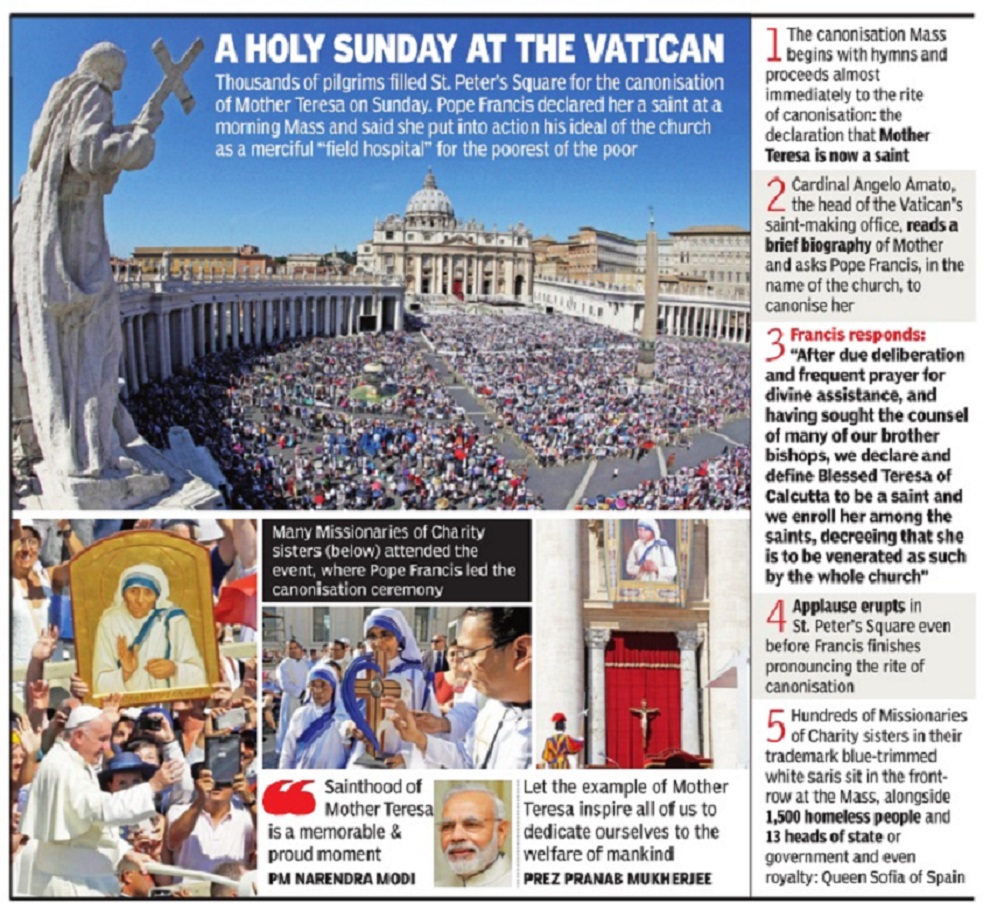
Graphic: The Times of India
Mother Teresa declared a saint by Pope Francis in Vatican City, Agencies | Sep 4, 2016
Pope Francis declared revered nun Mother Teresa+ a saint in a canonization mass+ at St Peter's square on Sep 4, 2016.
"For the honour of the Blessed Trinity, the exaltation of the Catholic faith... ... we declare and define Blessed Teresa of Calcutta (Kolkata) to be a Saint and we enroll her among the Saints+ , decreeing that she is to be venerated as such by the whole Church," the pontiff said in Latin.
For Francis, Mother Teresa+ put into action his ideal of the church as a merciful "field hospital" for the poorest of the poor, those suffering both material and spiritual poverty.
The elevation of one of the icons of 20th Century Christianity came a day before the 19th anniversary of her death in Kolkata, where she spent nearly four decades working with the dying and the destitute.
Tens of thousands of pilgrims — rich and poor, powerful and homeless — filled St. Peter's Square on Sunday for the canonization of Mother Teresa, the tiny nun who cared for the world's most destitute and became an icon of a Catholic Church that goes to the peripheries to find lost souls.
Throughout the night, pilgrims prayed at vigils in area churches and flocked before dawn to the Vatican to try to get a good spot for the Mass being celebrated under a searing hot sun and blue skies.
13 heads of state and government led official delegations while 1,500 homeless people invited by Pope Francis had VIP seats and were going to be treated by the pope to a Neapolitan pizza lunch in the Vatican auditorium afterward.
While Francis is clearly keen to hold Mother Teresa up as a model for her joyful dedication to society's outcasts, he is also recognizing holiness in a nun who lived most of her adult life in spiritual agony sensing that God had abandoned her.
"What she described as the greatest poverty in the world today (of feeling unloved) she herself was living in relationship with Jesus," he said in an interview on the eve of the canonization.
Francis has in many ways modeled his papacy on Mother Teresa's simple lifestyle and selfless service to the poor: He eschewed the Apostolic Palace for a hotel room, he has made welcoming migrants and the poor a hallmark and has fiercely denounced today's "throwaway" culture that discards the unborn, the sick and the elderly with ease.
Sunday's festivities honouring Mother Teresa weren't limited to Rome: In Kolkata, where Mother Teresa spent a lifetime dedicated to the poor, a special Sunday Mass was held at the order's Mother House. Volunteers and admirers converged on Mother House to watch the canonization ceremony, which was being broadcast on giant TV screens in Kolkata and elsewhere.
"Let the example of Mother Teresa inspire all of us to dedicate ourselves to the welfare of mankind," said Indian President Pranab Mukherjee.
Ceremonies were also expected in Skopje, Macedonia, where Mother Teresa was born, and also in Albania and Kosovo, where people of her same ethnic Albanian background live.
2017: declared patron saint of Calcutta Archdiocese
Mother Teresa is patron saint of Kolkata, Sep 7, 2017: The Times of India
The Vatican declared Mother Teresa a patron saint of the Archdiocese of Calcutta at a Mass in the city where she dedicated her life to the poorest of the poor. The honor came 16 months after Pope Francis declared Mother Teresa a saint.
About 500 people attended the Mass where vicar general Dominique Gomes read the decree instituting her as the second patron saint of the archdiocese. Mother Teresa's name will be mentioned whenever people under the archdiocese pray or a Mass is held. The Vatican's ambassador to India, Giambattista Diquattro, led the Mass and inaugurated a bronze statue of Mother Teresa carrying a child.
The Missionaries of Charity
2016: Nineteen years after St. Teresa
Mother Teresa's mission lives on in Kolkata, grows worldwide
Highlights:
1. The Missionaries of Charity gained world renown, and Mother Teresa a Nobel peace prize.
2. There is no change in our way of treating the sick and dying: Sister, Nirmal Hriday
3. Hundreds of thousands are expected to gather in Rome on Sunday for a canonisation service led by Pope Francis.
The Missionaries of Charity gained world renown, and Mother Teresa a Nobel peace prize, by caring for the dying, the homeless and orphans gathered from the teeming streets of the city in eastern India. They also drew criticism for propagating what one sceptic has called a cult of suffering; for failing to treat people whose lives might have been saved with hospital care; and for trying to convert the destitute to Christianity.
While staying true to their cause, the Missionaries of Charity say they have responded to their detractors.
"There is no change in our way of treating the sick and dying - we follow the same rule that Mother had introduced," said Sister Nicole, who runs the Nirmal Hriday home in the ancient district of Kalighat, the first to be set up by Mother Teresa in 1952.
The nuns no longer picked up people "randomly" off the streets, she said, and only took in the destitute at the request of police.
"Any good work will be challenged - but if the work is genuinely good it will survive such criticism and carry on to be God's true work," said Nicole.
PRAYER AND WORK
Hundreds of thousands are expected to gather in Rome on Sunday for a canonisation service led by Pope Francis, leader of the world's 1.2 billion Roman Catholics, in front of St Peter's Basilica. Kolkata, as the former capital of the British Raj is now called, is holding prayers, talks and cultural events. But no major ceremony is planned to mark the path to sainthood for the two miracles of healing attributed to Mother Teresa. The low-key mood reflects an often-heated debate over religious intolerance in India, a predominantly Hindu country of 1.3 billion people.
Although Prime Minister Narendra Modi has said Indians felt "proud" about the canonisation, the head of a Hindu grassroots movement that supports his government provoked controversy last year by accusing Mother Teresa of seeking to convert people to Christianity. Her order denies this.
Kolkata Archbishop Thomas D'Souza played down any suggestion that Mother Teresa was not loved and respected by people of other faiths in a city that is home to 170,000 Roman Catholics. "Mother is certainly not a goddess to them," he told Reuters. "But she is deeply venerated and people - cutting across caste, community and creed - are respectful to her work." The everyday work of the Missionaries of Charity goes on, meanwhile. On a recent day at the spartan Kalighat home, male inmates with shaven heads and wearing green uniforms lay on bunks. Women ate in a canteen while others were cared for by volunteers. One inmate, a man of about 40 called Saregama, had just died.
"Saregama died with dignity and care," said Sister Nicole. "We prayed for him."
The number of homes that the Missionaries of Charity run has grown to nearly 750 in India and abroad, from the 600 that Mother Teresa left when she died in 1997.
At Mother House, her old headquarters down a narrow lane, the mood was one of silent prayer. Inside, a notice still hung on the wall saying: "Time to see Mother Teresa: 9 am to 12 noon/3 pm to 6 pm. Thursday closed."
Mother House still attracts visitors to India like Pedro Afonso, a lawyer from Brazil who had come with a friend for evening mass. He gave thanks for the miracles that will bring sainthood to Mother Teresa and said that, in Kolkata, she "had chosen the right place for her work and charity".
